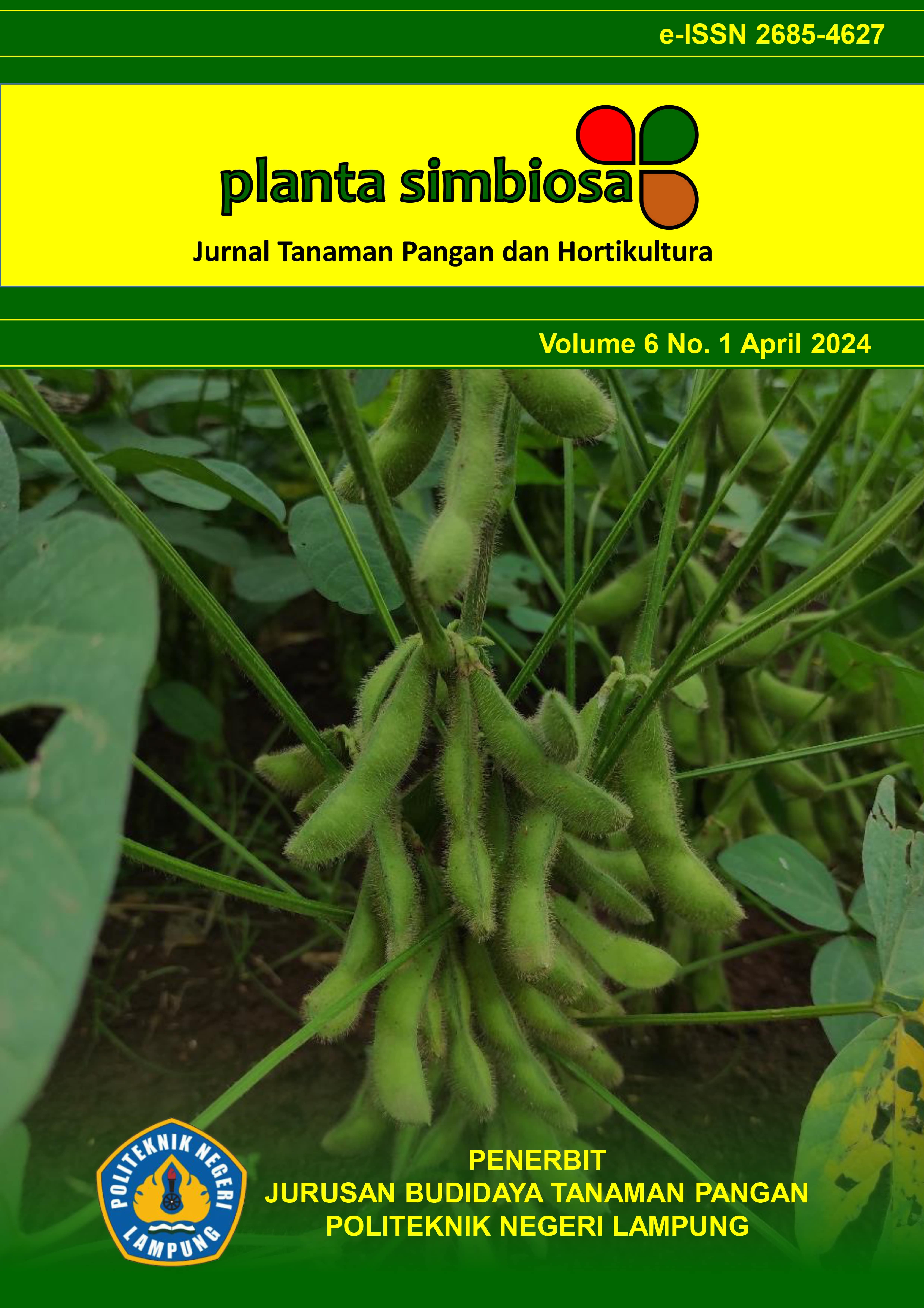Production of Five Varieties of Soybeans (Glycine Max L.) in Instalation of Agricultural Technology Research and Assessment Installation (IP2TP) Jambegede Malang
DOI:
https://doi.org/10.25181/jplantasimbiosa.v6i1.3288Abstract
Soybeans are one of the main food crop commodities, which have high nutritional content, especially the protein content contained in soybean seeds. Population increases and soybean production areas become narrower, so farmers can plant various superior varieties of soybeans. The aim of this final assignment is to determine the yield of soybean production from five varieties. The morphology of these five varieties is different, namely in roots, leaf shape, stems, flower color, pods and seeds. Superior varieties have superior properties compared to local varieties, so superior varieties can increase soybean production. This final assignment will be carried out from February to June 2023 at IP2TP Jambegede under the auspices of the Various Nuts Plant Standard Instrument Testing Center (BPSIT), Malang, East Java. The varieties observed were the Dega-1, Dena-1, Dena-2, Devon-1, and Devon-2 varieties, by observing plant height, number of branches, weight of filled pods, number of filled pods, number of empty pods, weight of 100 seeds, number of fertile nodes, plant growth, seed weight. Based on the weight of the production results observed, the Dega-1 soybean variety had the largest weight and Dena-1 had the smallest weight. Of the number of tiled plants that grow, the Dega-1 variety is the variety that has the most plants and the tiles that grow the least are Dena-2. Keywords: production, soybeans, varietiesDownloads
References
BPS. (2022, December 16). Analisis Produktivitas Jagung dan Kedelai di Indonesia 2021. Https://Www.Bps.Go.Id/Publication/2022/12/16/9e87d65dae851717a1af5784/Analisis-Produktivitas-Jagung-Dan-Kedelai-Di-Indonesia-2021.Html.
Lin, F., Chhapekar, S. S., Vieira, C. C., Da Silva, M. P., Rojas, A., Lee, D., Liu, N., Pardo, E. M., Lee, Y.-C., & Dong, Z. (2022). Breeding for disease resistance in soybean: a global perspective. Theoretical and Applied Genetics, 135(11), 3773–3872.
Liu, S., Zhang, M., Feng, F., & Tian, Z. (2020). Toward a “green revolution” for soybean. Molecular Plant, 13(5), 688–697.
Priyadi, P., Taisa, R., Dulbari, D., Rochman, F., & Rahmadi, R. (2023). Adaptation of several types of upland rice to aluminum stress and blast disease on Ultisols in Lampung Province. Jurnal Agrotek Ummat, 10(2), 195–205.
Rochman, F., & Firdaus, D. H. (2023). Kombinasi Takaran Kapur dan Pupuk Fosfat Terhadap Pertumbuhan dan Hasil Tanaman Kedelai (Glycine max (L.) Merrill) Kultivar Anjasmoro. JURNAL AGROREKTAN, 9(1). https://ejournal.unsub.ac.id/index.php/agrorektan/article/view/1742
Song, X.-P., Hansen, M. C., Potapov, P., Adusei, B., Pickering, J., Adami, M., Lima, A., Zalles, V., Stehman, S. V, & Di Bella, C. M. (2021). Massive soybean expansion in South America since 2000 and implications for conservation. Nature Sustainability, 4(9), 784–792.
Yuriansyah, Y., Sudrajat, D., Mutaqin, Z., Sari, E. Y., & Maharani, J. S. (2023). Aplikasi Trichoderma sp. dan pupuk NPK terhadap pertumbuhan dan hasil tanaman kedelai (Glycine max L.) varietas Grobogan. J-Plantasimbiosa, 5(1), 29–41.








